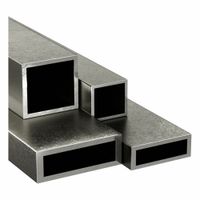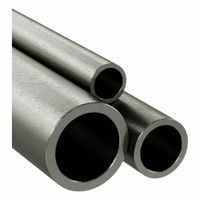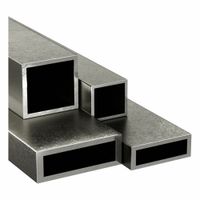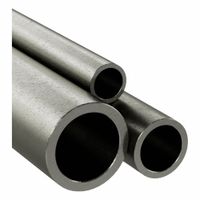Call +(254) 703 030 000 / 751 483 999 / 721 704 777
- Home
- Raw Materials
- Metals
- Carbon Steel
- Carbon Steel Tubes
.....Read More
Frequently Asked Questions
What are the advantages of using carbon steel tubes?
Carbon steel tubes offer several advantages:
1. **Strength and Durability**: Carbon steel is known for its high tensile strength, making it ideal for applications requiring durability and resistance to mechanical stress.
2. **Cost-Effectiveness**: Compared to other materials like stainless steel or copper, carbon steel is more affordable, providing a cost-effective solution for various industrial applications.
3. **Versatility**: Carbon steel tubes can be used in a wide range of applications, including construction, automotive, and machinery, due to their adaptability to different environments and conditions.
4. **Heat Resistance**: Carbon steel can withstand high temperatures, making it suitable for use in high-temperature applications such as boilers and heat exchangers.
5. **Corrosion Resistance**: While not as corrosion-resistant as stainless steel, carbon steel can be treated with coatings or galvanization to enhance its resistance to rust and corrosion.
6. **Ease of Fabrication**: Carbon steel tubes are easy to cut, bend, and weld, allowing for efficient fabrication and installation in various projects.
7. **Recyclability**: Carbon steel is fully recyclable, making it an environmentally friendly option that supports sustainable practices.
8. **Pressure Handling**: Carbon steel tubes can handle high pressure, making them suitable for use in pipelines and pressure vessels.
9. **Availability**: Carbon steel is widely available, ensuring a steady supply for manufacturing and construction needs.
10. **Customizability**: They can be manufactured in various sizes and thicknesses to meet specific requirements, offering flexibility in design and application.
These advantages make carbon steel tubes a popular choice across multiple industries, balancing performance, cost, and sustainability.
How are carbon steel tubes manufactured?
Carbon steel tubes are manufactured through several key processes:
1. **Raw Material Selection**: High-quality steel billets or coils are chosen based on the desired properties of the final product.
2. **Heating**: The raw steel is heated in a furnace to a temperature suitable for forming.
3. **Piercing**: For seamless tubes, the heated billet is pierced using a rotary piercing mill to create a hollow tube. For welded tubes, steel sheets are rolled into a tube shape.
4. **Elongation**: The pierced billet is elongated using a mandrel mill or plug mill to achieve the desired diameter and wall thickness.
5. **Welding (for welded tubes)**: The edges of the rolled sheet are welded together using techniques like electric resistance welding (ERW) or submerged arc welding (SAW).
6. **Sizing and Shaping**: The tube is passed through sizing mills to achieve precise dimensions and roundness.
7. **Heat Treatment**: The tubes may undergo heat treatment processes like annealing or normalizing to enhance mechanical properties.
8. **Straightening**: The tubes are straightened using straightening machines to ensure uniformity.
9. **Cutting**: Tubes are cut to the required lengths using saws or cutting machines.
10. **Surface Treatment**: Processes like pickling, galvanizing, or coating are applied to improve corrosion resistance.
11. **Inspection and Testing**: Tubes undergo rigorous quality checks, including dimensional inspection, non-destructive testing, and pressure testing to ensure they meet industry standards.
12. **Packaging and Shipping**: Finished tubes are bundled, labeled, and prepared for shipment to customers.
These steps ensure the production of high-quality carbon steel tubes suitable for various industrial applications.
What are the common applications of carbon steel tubes?
Carbon steel tubes are widely used across various industries due to their strength, durability, and cost-effectiveness. Common applications include:
1. **Construction and Infrastructure**: Carbon steel tubes are used in structural frameworks for buildings, bridges, and other infrastructure projects due to their high strength and load-bearing capacity.
2. **Automotive Industry**: They are used in the manufacturing of vehicle components such as exhaust systems, chassis, and suspension parts, providing durability and resistance to wear and tear.
3. **Oil and Gas Industry**: Carbon steel tubes are essential in the transportation of oil, gas, and other fluids. They are used in pipelines, drilling rigs, and refineries due to their ability to withstand high pressure and temperature.
4. **Mechanical and Heavy Equipment**: These tubes are used in the production of machinery and equipment, including agricultural machinery, cranes, and industrial machines, due to their robustness and ability to handle stress.
5. **HVAC Systems**: In heating, ventilation, and air conditioning systems, carbon steel tubes are used for ductwork and piping, offering efficient thermal conductivity and strength.
6. **Energy Sector**: They are used in power plants for steam and water conveyance, as well as in renewable energy systems like wind turbines for structural components.
7. **Shipbuilding and Marine Applications**: Carbon steel tubes are used in the construction of ships and marine structures, providing resistance to corrosion and harsh marine environments.
8. **Furniture and Appliances**: They are used in the manufacturing of furniture frames and household appliances, offering a balance of strength and aesthetic appeal.
9. **Firefighting Systems**: Carbon steel tubes are used in sprinkler systems and fire suppression systems due to their reliability and ability to handle high-pressure water flow.
These applications highlight the versatility and essential role of carbon steel tubes in various sectors.
How do you prevent carbon steel tubes from rusting?
To prevent carbon steel tubes from rusting, several methods can be employed:
1. **Coatings and Paints**: Apply protective coatings such as epoxy, polyurethane, or zinc-rich primers. These create a barrier between the steel and the environment.
2. **Galvanization**: Coat the steel with a layer of zinc through hot-dip galvanizing or electro-galvanizing. Zinc acts as a sacrificial anode, corroding before the steel does.
3. **Corrosion Inhibitors**: Use chemical compounds that slow down corrosion. These can be applied as a surface treatment or added to the environment surrounding the steel.
4. **Cathodic Protection**: Implement sacrificial anodes or impressed current systems to redirect corrosion to a more easily corroded metal.
5. **Environmental Control**: Reduce exposure to moisture and corrosive elements by controlling the environment, such as using dehumidifiers or storing in dry, covered areas.
6. **Stainless Steel Cladding**: Cover carbon steel with a layer of stainless steel to provide a corrosion-resistant surface.
7. **Regular Maintenance**: Conduct regular inspections and maintenance to identify and address early signs of rust.
8. **Use of Corrosion-Resistant Alloys**: Opt for low-alloy steels with added elements like chromium or nickel to enhance corrosion resistance.
9. **Proper Design**: Design structures to avoid water traps and ensure proper drainage, reducing prolonged exposure to moisture.
10. **Passivation**: Treat the steel surface with an acid solution to remove free iron and form a protective oxide layer.
Implementing a combination of these methods based on the specific application and environmental conditions will effectively prevent rusting of carbon steel tubes.
What is the difference between carbon steel tubes and stainless steel tubes?
Carbon steel tubes are primarily composed of iron and carbon, with a higher carbon content than stainless steel. This composition makes them strong, durable, and cost-effective, but more prone to corrosion. They are often used in applications where strength is more critical than resistance to corrosion, such as in structural and mechanical applications, pipelines, and automotive components.
Stainless steel tubes, on the other hand, contain iron, carbon, and a significant amount of chromium, typically at least 10.5%. The chromium forms a passive layer of chromium oxide on the surface, which prevents rust and corrosion, making stainless steel highly resistant to environmental and chemical exposure. This property makes stainless steel tubes ideal for applications requiring high corrosion resistance, such as in the food and beverage industry, medical devices, and chemical processing.
In terms of appearance, stainless steel tubes have a shiny, polished finish, while carbon steel tubes have a more matte, dull appearance. Stainless steel is also more expensive due to its alloying elements and corrosion-resistant properties.
In summary, the primary differences between carbon steel and stainless steel tubes lie in their composition, corrosion resistance, cost, and typical applications. Carbon steel is stronger and more affordable but less resistant to corrosion, while stainless steel offers superior corrosion resistance and a polished appearance at a higher cost.
How do you measure the dimensions of carbon steel tubes?
To measure the dimensions of carbon steel tubes, follow these steps:
1. **Outer Diameter (OD):** Use a caliper or micrometer to measure the outer diameter. Place the tool around the tube's circumference and ensure it is perpendicular to the tube's axis for an accurate reading.
2. **Inner Diameter (ID):** If the tube is accessible from the inside, use an inside micrometer or telescoping gauge to measure the inner diameter. Insert the tool into the tube, expand it to touch the inner walls, and then measure the distance.
3. **Wall Thickness:** Calculate the wall thickness by subtracting the inner diameter from the outer diameter and dividing by two. Alternatively, use an ultrasonic thickness gauge for a direct measurement, especially for larger tubes.
4. **Length:** Use a tape measure or a laser distance measurer to determine the tube's length. Ensure the tube is straight and measure from end to end.
5. **Roundness:** Check for roundness by measuring the outer diameter at multiple points along the circumference. Compare these measurements to ensure uniformity.
6. **Straightness:** Use a straight edge or laser alignment tool to check the tube's straightness. Place the straight edge along the tube's length and look for gaps or deviations.
7. **Surface Finish:** Inspect the surface finish visually or use a surface roughness tester to quantify the finish quality.
8. **End Squareness:** Use a square or angle gauge to ensure the tube ends are perpendicular to the tube's axis.
These measurements ensure the tube meets the required specifications and tolerances for its intended application.
What are the different grades of carbon steel tubes?
Carbon steel tubes are categorized based on their carbon content, manufacturing process, and specific applications. The primary grades include:
1. **Low Carbon Steel Tubes (Mild Steel):** Contain up to 0.3% carbon. They are highly ductile, malleable, and easy to weld, making them suitable for structural applications, automotive parts, and general engineering purposes.
2. **Medium Carbon Steel Tubes:** Contain 0.3% to 0.6% carbon. These tubes offer a balance between strength and ductility, making them ideal for machinery parts, axles, and shafts.
3. **High Carbon Steel Tubes:** Contain 0.6% to 1.0% carbon. They are very strong and hard but less ductile, used in high-strength applications like cutting tools and springs.
4. **Ultra-High Carbon Steel Tubes:** Contain 1.0% to 2.0% carbon. These are extremely hard and brittle, used in specialized applications like knives and punches.
5. **Seamless Carbon Steel Tubes:** Manufactured without a seam, offering higher pressure resistance and strength. Commonly used in high-pressure applications like oil and gas transportation.
6. **Welded Carbon Steel Tubes:** Made by welding a seam, suitable for lower pressure applications. They are cost-effective and used in construction and plumbing.
7. **Alloyed Carbon Steel Tubes:** Contain additional elements like manganese, silicon, or copper to enhance properties like strength, corrosion resistance, and toughness. Used in demanding environments.
8. **Heat-Treated Carbon Steel Tubes:** Undergo processes like annealing, quenching, or tempering to improve mechanical properties. Used in applications requiring specific strength and hardness.
Each grade serves distinct industrial needs, balancing factors like cost, strength, ductility, and resistance to environmental conditions.



